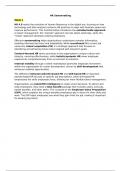HR Samenvatting
Week 1
HR 4.0 marks the evolution of Human Resources in the digital era, focusing on how
technology and data analytics enhance HR practices to align with business goals and
improve performance. This transformation introduces the outside/inside approach
to talent management: the "outside" approach recruits talent externally, while the
"inside" approach develops existing employees.
Effective sensemaking helps organizations understand complex information,
enabling informed decisions and adaptability. While recruitment fills current job
vacancies, talent acquisition (TA) is a strategic approach that focuses on
identifying and attracting future talent aligned with long-term goals.
Context-focused HR tailors practices to the organization's unique culture and
industry, ensuring effectiveness, while holistic/systemic HR views employee
experiences comprehensively from recruitment to retention.
Internal mobility through a talent marketplace promotes employee movement
within the organization for career development, driven by skill development that
enhances mobility opportunities.
The difference between job/role-based HR and skill-based HR is important:
job/role-based HR focuses on specific job descriptions, while skill-based HR
emphasizes the skills employees have, allowing for more flexible talent management.
Organizations use talent/HR intelligence to make smart decisions. To attract and
keep employees, they need a total benefit package that includes salary, bonuses,
health benefits, and other perks. This is based on the Employee Value Proposition
(EVP), which explains the unique benefits employees get in return for their skills and
work. The EVP helps employees see what they gain from the job, making it important
for keeping top talent.
, Week 2
Talent refers to a person’s abilities, skills, and attitude, which together shape how
they perform at work. In today’s job market, many companies face a talent crunch,
meaning there aren’t enough skilled workers available for open positions. This
shortage can be partly due to the skill gap at the individual level, where workers
may lack the skills that employers want. At the organizational level, companies
may find that their employees’ overall skills don’t align with the business’s needs.
To address this talent crunch, companies can use effective talent acquisition (TA)
strategies to attract and keep skilled workers. Additionally, skill-based HR practices
can help close the skill gap by focusing on the specific skills needed for various roles
and providing the necessary training.
Job design plays a key role in enhancing employee satisfaction by organizing roles
in a way that fits the workers’ strengths. Furthermore, job crafting allows
employees to adjust their roles to better suit their interests and abilities.
Understanding the different generations in the workplace, especially Gen Z, is also
crucial for effective talent management.
The mental model of an organization reflects how employees think and work
together, influencing the overall culture. Viewing talent through a cognitive
perspective emphasizes the importance of knowledge and skills. As companies
redefine talent to include these elements, they also recognize the increasing need for
soft skills like communication and teamwork. Ultimately, the concept of the
memory of the future encourages organizations to prepare for upcoming
challenges, ensuring they remain adaptable in a constantly changing environment.




